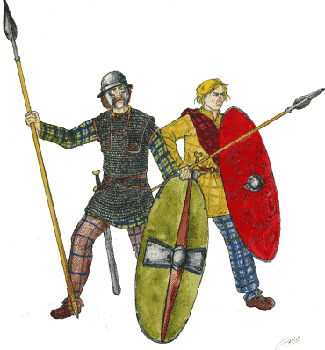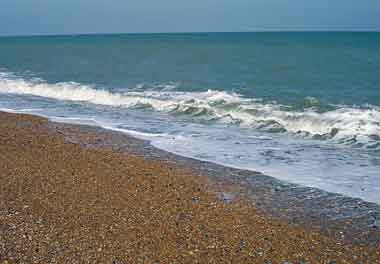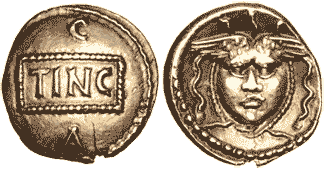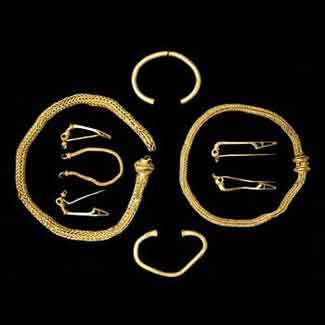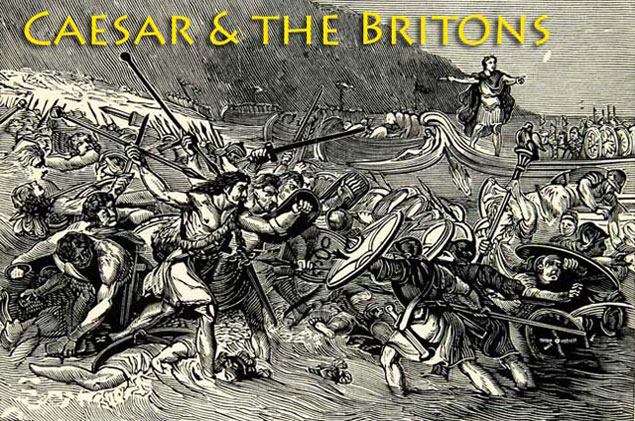
Gaius Julius Caesar
Caesar was a Roman politician from a very proud and venerable family but, although the Julii reckoned themselves the descendants of Aeneas (and, through him, of the goddess Venus), they had never played a particularly prominent role in civic affairs until the first century BC. The Rome into which he was born in 100 BC was being torn apart by political factions, and was about to 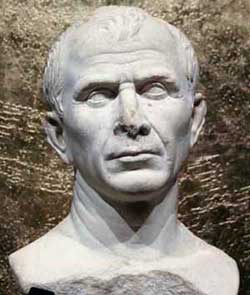 go through a series of civil wars that only ended some seventy years later with the establishment of a monarchy in 30BC by his nephew Augustus. Rome had long been riven with class divisions and these were currently manifested in the struggle between the populares and the optimates. When Caesar (left) was a young man these factions were led by Gaius Marius and Lucius Cornelius Sulla respectively. They owed their power to their success as generals and the armed backing of the troops they commanded, which introduced a new and deadly element into the political mix to go along with the jealousy and competitive nature of the noble families of Rome, each of whom commanded a vast patronage network.
go through a series of civil wars that only ended some seventy years later with the establishment of a monarchy in 30BC by his nephew Augustus. Rome had long been riven with class divisions and these were currently manifested in the struggle between the populares and the optimates. When Caesar (left) was a young man these factions were led by Gaius Marius and Lucius Cornelius Sulla respectively. They owed their power to their success as generals and the armed backing of the troops they commanded, which introduced a new and deadly element into the political mix to go along with the jealousy and competitive nature of the noble families of Rome, each of whom commanded a vast patronage network.
Caesar’s father had been a supporter of Marius, who was married to his sister, but he was dead when his son was still a teenager and before the eventual triumph of Sulla. Roman politics was literally a cut throat business in those days and Caesar was fortunate to have escaped the bloody purges that followed, in which thousands had died, with his life. He was stripped of his wealth, however, and the only hope he had of restoring the family fortunes was through a political career. Young Gaius turned out to be a born politician, however, a natural demagogue and an adept deal maker.
In the Roman Republic, ostensibly a democracy, the greater the office the greater the price that had to be paid—whether in terms of outright bribes, gangs of hired thugs, or lavish entertainments to sway the voting public. However, if you survived the course (the cursus honorum), the payoff could be enormous. The ultimate prize was a provincial governorship, generally awarded to men who had served as praetor or consul, the highest ranks in the Roman system, who were known as proconsuls or propraetors. The fleecing of provincials—through bribery, kickbacks and outright extortion—was the ultimate prize as far as the Roman ruling classes were concerned. Imagine Al 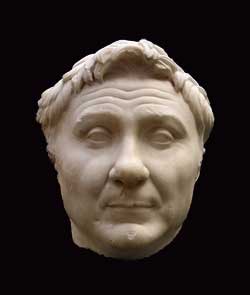 Capone with the full backing of the most powerful state in the world and virtual immunity from prosecution and you have some idea of their nature.
Capone with the full backing of the most powerful state in the world and virtual immunity from prosecution and you have some idea of their nature.
Caesar’s rise through the ranks was steady and he filled each of the higher offices in turn. In 63BC he was elected Pontifex Maximus, the chief priest of the Roman state religion. The next year he served as praetor, and as governor of Spain in the one after that. But his creditors were hard on his heels. Fortunately for him there was a power struggle going on between Gnaeus Pompeius Magnus (left), a military hero who had the backing of thousands of serving soldiers as well as tens of thousands of retired veterans, and Marcus Licinius Crassus (the wealthiest man in Rome). Caesar brokered a deal between the two of them and, with their support, offered himself as consul (one of the two heads of state chosen each year) in 60BC.
The subsequent election was corrupt, even by Roman standards but, with Crassus’ money and Pompey’s thugs, Caesar prevailed. After a term in office that was turbulent to say the least he was given the provinces of Gallia Cisalpina (northern Italy) and Illyricum (the Balkan coast of the Adriatic) to run for an unprecedented term of five years, during which he would be immune from prosecution. By timely bit of luck, the governor of Gallia Transalpina (the regions of Provence and Languedoc in southern France) died suddenly and Caesar was appointed to take his place.
By these appointments, Caesar was thus given effective control of Rome’s northern frontier, beyond which were enough 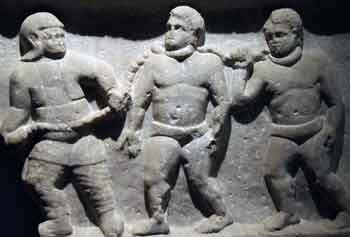 ‘uncivilised’ tribes to make the reputation of the right sort of commander. More importantly, there was a huge amount of outright plunder that could be had in the course of a successful military campaign. Portable loot such as works of art or precious metals was preferred, but these were more commonly found in Hellenized East. However, human chattels (prisoners-of-war and their families) were at least as valuable if not more so. The Roman economy was almost entirely dependent on slave-labour and there was an ongoing demand for fresh supplies.
‘uncivilised’ tribes to make the reputation of the right sort of commander. More importantly, there was a huge amount of outright plunder that could be had in the course of a successful military campaign. Portable loot such as works of art or precious metals was preferred, but these were more commonly found in Hellenized East. However, human chattels (prisoners-of-war and their families) were at least as valuable if not more so. The Roman economy was almost entirely dependent on slave-labour and there was an ongoing demand for fresh supplies.
He had four legions under his command but had the right to raise more—both legionaries and auxiliaries—should the situation require. Legionaries, who were mainly recruited from the urban proletariat, looked to their commanders rather than the state to take care of them after their campaigning days were over. When they were too old to fight after twenty years or so of service, they expected land to farm. Meanwhile they looked forward to the chance of picking up a little booty.
The Romans and the Gauls
The tribes of northern Europe had long been a source of dread to the average Roman, ever since the Gauls first burst upon the scene some 350 years earlier, at the beginning of the fourth century BC. They had come out of nowhere streaming through the Alpine passes and had laid waste to all of northern Italy, destroying Etruscan civilization in the process. They even sacked Rome itself in 391BC. They only agreed to withdraw from the city after the payment of an enormous tribute. Eventually the bulk of 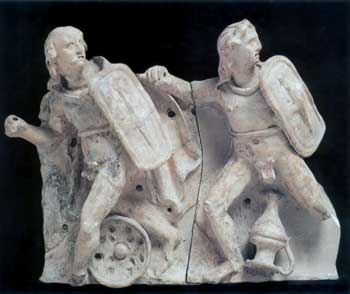 them settled in the Po Valley and posed a dire threat for the next two hundred years and formed the backbone of Hannibal’s army during the critical years of the war with Carthage.
them settled in the Po Valley and posed a dire threat for the next two hundred years and formed the backbone of Hannibal’s army during the critical years of the war with Carthage.
At left is part of a frieze from a second century BC sanctuary at Civitalba, near Ancona on the Adriatic coast. This is a fairly standardized composition, known as a Gallomachy. It depicts a party of Gauls who, after having ransacked a temple, are fleeing the wrath of the gods.
After the defeat of Hannibal in 202 BC, the tribes of the Po Valley were finally subdued and constituted as a Roman province. It took another hundred years or so to pacify the tribes along the coastal strip to Spain. The rest of Gaul, according to Caesar, was divided into three parts—with the Belgae occupying what we would call "the Low Countries," the Aquitani in the southwest and the Celts occupying the area between. Only fifty years earlier the city had come within a whisper of a repeat performance when migratory tribes from what is now Denmark—the Cimbri, Teutones and Ambrones—annihilated every Roman army sent against them. It was only the military skill of the Gaius Marius that put an end to the threat, for which he was acclaimed as the city’s third founder.
From what we know of them—mainly through archaeology and the descriptions of ancient authors—the Gauls appear to have been a highly civilized people 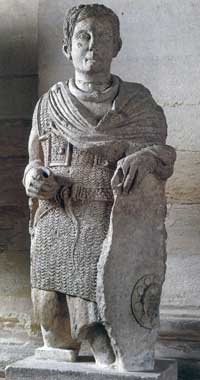 with a rich literary tradition (albeit an oral one) and sophisticated belief and social systems. They had an aristocratic society organized on a tribal basis, often with groups of tribes coming together (voluntarily or otherwise) to form larger political aggregations. Many Classical writers viewed it as a ‘heroic’ society, bound together by complicated rules of hospitality and mutual obligation. —the chief provided for his followers and they supported him with their swords. The more generous he was, the more followers he attracted.
with a rich literary tradition (albeit an oral one) and sophisticated belief and social systems. They had an aristocratic society organized on a tribal basis, often with groups of tribes coming together (voluntarily or otherwise) to form larger political aggregations. Many Classical writers viewed it as a ‘heroic’ society, bound together by complicated rules of hospitality and mutual obligation. —the chief provided for his followers and they supported him with their swords. The more generous he was, the more followers he attracted.
The statue of a Gaulish chief (shown right) was found at Vachères in the south of France depicts a proud warrior wearing a torque around his neck, a tunic of chain mail, He has a sword slung at his waist and his arm is resting on his shield.
The sources agree that the feast was of paramount importance in the Celtic world. It gave the leader an opportunity to display his largess and to reward his followers according to their service. The more generous the lord the more men he attracted. The most prestigious item on the menu was fine Italian wine and there was a huge market for this along with all of the paraphernalia that went along with it. The latter included the finest drinking vessels, enormous bowls known as kraters for mixing the wine (which was generally served watered down and flavoured with various herbs and spices). According to the historian Diodorus Siculus, a contemporary of Caesar’s, the going price was one slave for a jar of wine. Inevitably, this encouraged a vicious circle of slave-raiding, increased violence, the need for more warriors and an even greater demand for wine. Naturally, the Romans, who controlled the production took full advantage of the situation, playing the Gallic chiefs and tribes against one another
Caesar’s Gallic Wars
When Caesar arrived on the scene, the Gauls were already facing a very serious threat from the east. Population dynamics originating in the heart of the Eurasian landmass had created a ripple effect that resulted in various Germanic groups trying to force their way across the Rhine and settle in their land. Add a ruthless politician with pressing financial problems to the mix and the situation spelled disaster.
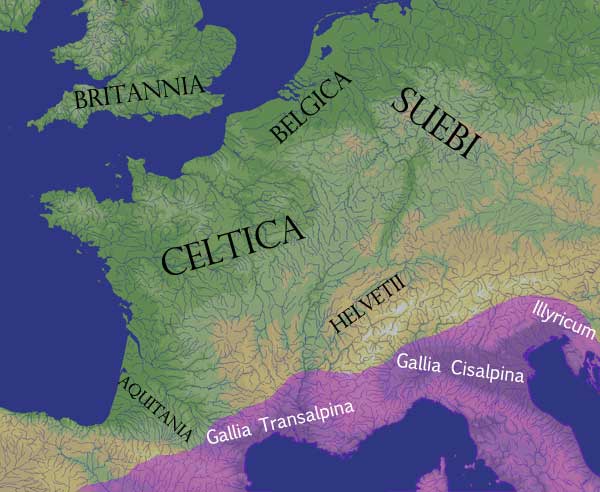
Caesar had already campaigned with most of his command in Spain during his governorship five years earlier. He proved to be a natural leader of men—daring yet careful with their lives, sharing in their privations and always in the thick of the fighting. Needless to say, they adored him. At the end of the campaign, he assembled an account of his activities during these years, Commentarii de Bello Gallico (Commentaries on the Gallic War). It was essentially a political document aimed at convincing the people of Rome that his actions were absolutely necessary. Naturally, he did not hesitate from exaggerating the dangers he had to confront in order to magnify his own role in dealing with them.
Intervening on behalf of Rome’s allies, Caesar inflicted crushing defeats on the invaders. First he dealt with the Helvetii, whose homeland lay in what is now Switzerland but who were looking for new 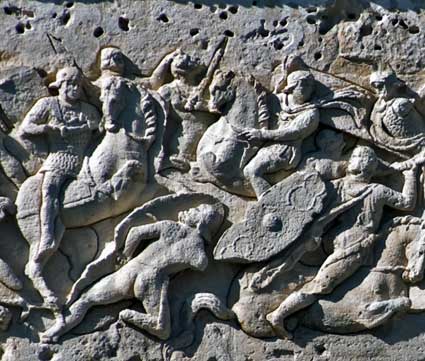 lands to the west. He then had to face the Suebi, a large confederacy from across the Rhine, who had recently established themselves in Gallic territory at the behest of certain of the local tribes. In a brutal campaign, he managed to drive them back over the river.
lands to the west. He then had to face the Suebi, a large confederacy from across the Rhine, who had recently established themselves in Gallic territory at the behest of certain of the local tribes. In a brutal campaign, he managed to drive them back over the river.
Even for her allies, Rome’s help came at a steep price and many Gauls deeply resented the fact that they were now being treated as Roman subjects, rather than as allies on an equal footing. When the Belgae, who lived in what was to become Flanders, began to take precautions by arming themselves, Caesar used it as an excuse for a preemptive strike and marched on them in 57 BC. It was another hard-fought campaign and losses were heavy on both sides, but eventually the Romans prevailed and established their control. Many of the Belgae fled the country, some of them seeking refuge with kinfolk in southeast Britain.
The next year saw him campaigning in north-western France to subdue a coalition of tribes led by the Veneti who dwelt along the Atlantic coast of what is now Brittany. They were a seafaring people with close commercial links to southwest Britain, whose trade monopoly was about to come to an end. As was the case with the Belgae, they also had close social and political cross-Channel connections that included military support. Caesar alleges that British warriors actively participated in this and earlier campaigns and, after the Veneti were subdued, turned his gaze in their direction.
The Invasions of Britain
The First Invasion (55BC)
The British Isles were not totally unfamiliar to educated Romans. The Phoenicians certainly knew of them and a Greek explorer, Pytheas of Massalia, actually visited them some three hundred years earlier. Even so, they were the back of beyond to 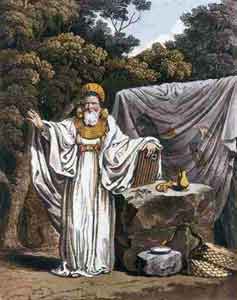 most Romans, an almost mythological land with strange institutions and bizarre rituals. It is not clear what Caesar’s long-term intentions were. His subsequent account plays up the idea of a British threat to Roman civilization. He even plays up the ‘international terrorism’ angle. He states that the Celtic priestly class, the Druids, were his fiercest opponents in Gaul, that their headquarters was in Britain and that the more dedicated among them received advanced training there. He is careful to point out the cruelty of their religion and its barbaric rites of human sacrifice—a notion that horrified civilized Romans as they queued for the gladiatorial games in the arena.
most Romans, an almost mythological land with strange institutions and bizarre rituals. It is not clear what Caesar’s long-term intentions were. His subsequent account plays up the idea of a British threat to Roman civilization. He even plays up the ‘international terrorism’ angle. He states that the Celtic priestly class, the Druids, were his fiercest opponents in Gaul, that their headquarters was in Britain and that the more dedicated among them received advanced training there. He is careful to point out the cruelty of their religion and its barbaric rites of human sacrifice—a notion that horrified civilized Romans as they queued for the gladiatorial games in the arena.
The political reality was that, at a meeting with the other triumvirs the year before, it was agreed that Caesar’s command (and his ‘diplomatic immunity’) would be extended for another five years. However, with Gaul apparently pacified there was little to justify what was intended as an emergency measure by the Senate. However, if the Britons were seen as a threat by the Roman public, it would suit his purposes very nicely. If he could subdue them and add their lands to the empire it would have given him enormous prestige as well as more tangible rewards in the form of loot.
Caesar decided upon a reconnaissance in force and set out in the late summer of 55 BC with a force consisting of two legions (the VIIth and Xth) and a separate detachment of cavalry:
It was now near the end of summer, and winter sets in early in those parts, because all that coast of Gaul faces north. Nevertheless, Caesar made active preparations for an expedition to Britain, because he knew that in almost all the Gallic campaigns the Gauls had received reinforcements from the Britons. Even if there was not time for a campaign that season, he thought it would be of great advantage to him merely to visit the island, to see what its inhabitants were like, and to make himself acquainted with the lie of the land, the harbours, and the landing-places. Of all this the Gauls knew next to nothing; for in the ordinary way traders are the only people who visit Britain, and even they know only that part of the coast which faces Gaul. And so, although he interviewed traders from all parts, he could not ascertain anything about the size of the island, the character and strength of the tribes which inhabit it, their manner of fighting and customs, or the harbours capable of accommodating a large fleet of ships.
(De Bello Gallico IV, 20)
One of his junior officers, a military tribune named Gaius Volusenus, was sent out in advance to scout the shore for landing places but did not actually go ashore. So Caesar had very little in the way of useful intelligence before he set off. He should have known, for instance, that the weather in 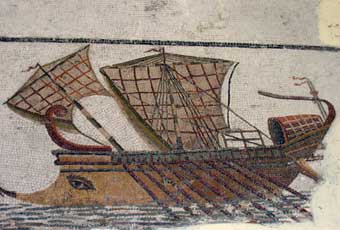 the Channel and North Sea can be particularly active at that time of year and that Mediterranean vessels were not designed to cope with the high tides and violent currents.
the Channel and North Sea can be particularly active at that time of year and that Mediterranean vessels were not designed to cope with the high tides and violent currents.
When Caesar’s intentions became known among the Britons, many of the tribes decided to make some sort of accommodation with him and sent envoys to offer their submission. These, he sent back to Britain accompanied by a Gaul named Commius, whom he had recently made king of the Atrebates tribe. The Atrebates were a Belgic tribe, with branches on both sides of the Channel and Commius was supposed to contact as many of the local tribes as possible and persuade them to come to terms. Things did not go according to plan, however, and he was taken prisoner as soon as he set foot on shore. The infantry set out in a flotilla of eighty transports guarded by warships, from an unnamed port, undoubtedly Portus Itius—later known as Gesoriacum (modern Boulogne)—but the cavalry, which was to set out from a different place, was held up by contrary tides and never did take part in the campaign. Their absence would be keenly felt.
The intention was to land at Dover but when they arrived they found the white cliffs surrounding the harbour were heavily defended and that any attempt at landing would be doomed to failure. So he headed north along the coast to Deal—shadowed all the way by the local forces—to attempt a landing but, here too, lack of proper reconnaissance nearly lead to disaster. An offshore shelf prevented the large boats from running up on the beach and there were no smaller vessels to serve as landing craft, so the men would have had to make their way to the beach, weighted down with their arms and armour, up to their necks in water. Caesar describes what followed:
These perils frightened our soldiers, who were quite unaccustomed to battles of this kind, with the result that they did not show the same alacrity and enthusiasm as the usually did in battles on dry land. Seeing this, Caesar ordered the warships—which were swifter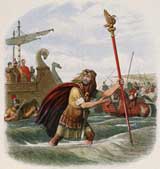 and easier to handle than the transports, and likely to impress the natives more by their unfamiliar appearance—to be removed a short distance from the others and then to be rowed hard and run ashore on the enemies right flank, from which position slings, bows, and artillery could be used by men on deck to drive them back. This manoeuvre was highly successful Scared by the strange shape of the warships, the motion of the oars, and the unfamiliar machines, the natives halted and retreated a little. But as the Romans still hesitated, chiefly on account of the depth of water, the man who carried the eagle (aquilifer) of the Xth Legion, after praying to the gods that his action might bring good luck to the legion, cried in a loud voice: ‘Jump down, comrades, unless you want to surrender our eagle to the enemy; I, at any rate, mean to do my duty to my country and my general.’ With these words he leapt out of the ship and advanced towards the enemy with the eagle in his hands.
and easier to handle than the transports, and likely to impress the natives more by their unfamiliar appearance—to be removed a short distance from the others and then to be rowed hard and run ashore on the enemies right flank, from which position slings, bows, and artillery could be used by men on deck to drive them back. This manoeuvre was highly successful Scared by the strange shape of the warships, the motion of the oars, and the unfamiliar machines, the natives halted and retreated a little. But as the Romans still hesitated, chiefly on account of the depth of water, the man who carried the eagle (aquilifer) of the Xth Legion, after praying to the gods that his action might bring good luck to the legion, cried in a loud voice: ‘Jump down, comrades, unless you want to surrender our eagle to the enemy; I, at any rate, mean to do my duty to my country and my general.’ With these words he leapt out of the ship and advanced towards the enemy with the eagle in his hands.
(De Bello Gallico IV, 25)
Shamed, the legionaries jumped into the sea straight after him and, after much hard fighting, achieved a beachhead and routed the opposition but the lack of cavalry meant he was unable to mount any sort of pursuit and consolidate his victory. The local Kentish tribes submitted right away, handing back Commius with their sincerest apologies, and agreed to hand over hostages.
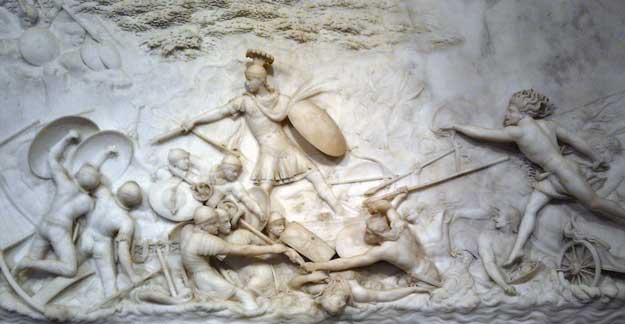
Relief of Caesar's Landing by John Deare
On the fourth day after the landings disaster struck. The transports bringing the cavalry in a second attempt at a crossing were driven back into port. Even worse, the storm, combined with a higher than normal tide, wrecked the main fleet as it lay beached or anchored just offshore. There were no other vessels available and they would soon be out of provisions. Seeing an opportunity to destroy the Romans, the tribes reneged on their agreement and began to assemble a large army. However, by a heroic effort, the Romans managed to repair most of the ships, one legion working while the other harvested grain from the surrounding countryside. It was while the VIIth Legion was out foraging that the British struck and it was only after some desperate fighting in front of the Roman camp that they were driven off. More hostages were swiftly produced and oaths of loyalty were sworn. Caesar really had no choice but to accept them. It was getting late in the year and the weather was only going to get worse. His jury-rigged ships were only just seaworthy, his lines of supply were extremely tenuous and it was abundantly clear that with a mere two legions with no cavalry support he could not accomplish anything much. So, after only a few short weeks the expedition sailed back to Gaul, no doubt considering themselves very fortunate.
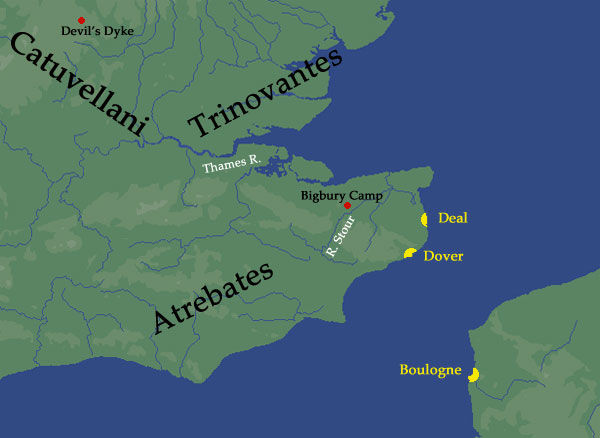
Map. Caesar’s Invasions of Britain
The Second Invasion (54BC)
There was no doubt in anyone’s mind, least of all his own, that Caesar intended to return and that this time he would be much better prepared. This time the fleet consisted of over 800 ships, the majority of which had been built over the winter according to Caesar’s specifications. These were broader in the beam and had a shallow draught to enable them to be run directly onto the beach. The extra ships were necessary because the invasion force was over twice as large—five legions (some 25,000 men) along with 2,000 cavalry.
They embarked from Portus Itius, which is specifically named this time, much earlier in the summer at the beginning of July. There was a good deal of trouble with wind and tide on the crossing but they eventually made it. The landing was unopposed this time—although the identity of the beach is unknown except 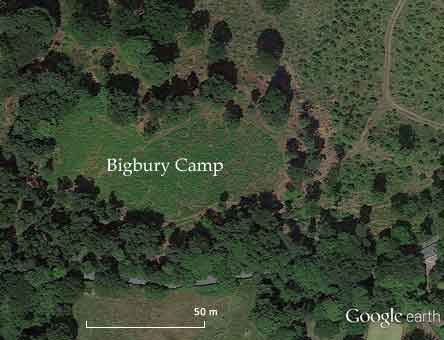 to say that it had been scouted the summer before. Caesar immediately set out on a night march with the bulk of his army, looking for the enemy. After 12 miles, they encountered a sizeable force of cavalry and chariotry ranged on the opposite bank of a river, probably the Stour which flows through Canterbury. These were pushed back and pursued to a fortified stronghold in the woods nearby—the Iron Age defences at Bigbury Camp, about a mile (1.5km) west of the crossing on what has always been the main road to London, fit the bill nicely. They appear formidable today but Caesar’s veterans had encountered similar many times before in Gaul and they were swiftly overcome. They formed a testudo and, under its protection, filled in the ditch and built a ramp against the palisades beyond. But the enemy were able to withdraw quickly and the Romans, having fought two engagements at the end of a lengthy march, were too exhausted to mount much of a pursuit.
to say that it had been scouted the summer before. Caesar immediately set out on a night march with the bulk of his army, looking for the enemy. After 12 miles, they encountered a sizeable force of cavalry and chariotry ranged on the opposite bank of a river, probably the Stour which flows through Canterbury. These were pushed back and pursued to a fortified stronghold in the woods nearby—the Iron Age defences at Bigbury Camp, about a mile (1.5km) west of the crossing on what has always been the main road to London, fit the bill nicely. They appear formidable today but Caesar’s veterans had encountered similar many times before in Gaul and they were swiftly overcome. They formed a testudo and, under its protection, filled in the ditch and built a ramp against the palisades beyond. But the enemy were able to withdraw quickly and the Romans, having fought two engagements at the end of a lengthy march, were too exhausted to mount much of a pursuit.
However lucky Caesar was on land, he had evidently done something to antagonize Neptune, the god of the sea, for that same night the Roman fleet was badly damaged by gale-force winds and it would take some time to repair the damage. Meanwhile, for the second time, the legions had to fend for themselves in enemy country. Caesar’s first concerns were to repair his ships and finish building the base camp, now enlarged to protect the fleet. All of this took time—ten days, according to Caesar—and the delay gave the British ample time to gather their forces.
As soon as the ships were hauled up and the camp strongly-fortified, Caesar .....returned to the place from which he had come. On arriving there he found that larger British forces had now been assembled from all sides by Cassivellaunus, to whom the chief command and direction of the campaign had been entrusted by common consent. Cassivellaunus’ territory is separated from the maritime tribes by a river called the Thames, and lies about seventy-five miles from the sea. Previously he had been continually at war with the other tribes, but the arrival of our army frightened them into appointing him their supreme commander.
(De Bello Gallico V, 11)
Caesar does not say, but he was probably ruler of what was later known as the Catuvellauni tribe, whose lands centred around what is now Hertfordshire.
With his lines of communication secure, Caesar resumed his march inland and soon found his legions attacked by British cavalry and chariotry deployed with great skill by his adversary. The Romans found the unfamiliar chariots particularly difficult to deal with:
...for the Britons would generally give ground on purpose and, after drawing them some distance from the legions, would jump down from their chariots and fight on foot, with the odds in their favour.
(De Bello Gallico V, 16)
At the end of the day, it was the discipline and pure tenacity of the Roman infantry won out in the end and they first broke and then scattered their foes. By the time the Romans fought their way to the Thames, where there was another pitched battle as they forced their way across intending to drive their way to the heart of Cassivellaunus’ territory. At that point the latter decided to dispense with massed levies and send them home while he headed north with an elite chariot force, intending to adopt a scorched earth policy coupled with hit-and-run guerilla tactics. These were initially successful but Cassivellaunus soon found his political arrangements crumbling away.
During this march envoys arrived from the Trinovantes, about the strongest tribe in south-eastern Britain. Mandubracius, a young prince of this tribe, had gone over to the continent to put himself under Caesar’s protection, having fled for his life when his father, the king of the Trinovantes, was killed by Cassivellaunus. The envoys promised to surrender and obey Caesar’s commands, and asked him to protect Mandubracius from Cassivellaunus and send him home to rule his people as king.
(De Bello Gallico V, 20)
In return, the Trinovantes offered up hostages and agreed to provide grain for his troops. Once agreement had been reached with the Trinovantes, a number of the other tribes quickly followed suit—Caesar names them as the Cenimagni, Segontiaci, Ancalites, Bibroci and Cassi—but, apartfrom the first of these who may be the.jpg) Iceni ofBoudicca’s day, the others had disappeared by the time the Emperor Claudius invaded a century later.
Iceni ofBoudicca’s day, the others had disappeared by the time the Emperor Claudius invaded a century later.
From them, Caesar gained intelligence as to the location of Cassivellaunus’ main base—probably the Iron Age defences known as the Devil’s Dyke (left) at Wheathampstead in Hertfordshire. He captured the place but, from his rather lacklustre description of the events, it would seem that it had been pretty much abandoned and Caesar only managed to round up some cattle and a few of the residents who could not manage to flee. Cassivellaunus quickly sued for peace and Caesar, anxious to depart, let him off lightly—hostages were surrendered and the king agreed to pay an annual tribute and not to molest his neighbours. At which point, the legions marched back to Kent and embarked for Gaul at the end of September—it was getting late in the campaigning year, the weather in the Channel was more and more chancy and his opponents were proving more resilient than he had hoped. Perhaps even more alarming were rumours of a Gallic uprising, which had to be dealt with before he could hope to continue with his British venture.
The Gallic Revolt did occur that winter (54/53BC) and its suppression took all of Caesar’s talent. His successes, however, caused nothing but jealousy and resentment among his political enemies in Rome. The death of their fellow triumvir Crassus, who was killed fighting the Parthians in the slaughter that was the Battle of Carrhae in 53BC, led to a showdown between Caesar and Pompey. The Civil Wars that followed lasted for another twenty years or so. Caesar won the first round, defeating Pompey at the Battle of Pharsalus in 48BC, but was assassinated four years later. This led to a second round of conflict that finally ended off the west coast of Greece when Caesar’s nephew, Octavian, defeated the forces of Mark Antony and the Egyptian queen, Cleopatra, at Actium in 31BC. Octavian took the name Augustus and the title of imperator and returned Rome to monarchy. Needless to say, unfinished business in Britain was very low on the agenda throughout the proceedings and stayed there for much of the next century as Rome rebuilt her strength and stabilized her frontiers.
However, the events of the invasions and the apparent ease with which the Romans were able to operate within their land had a profound effect on the political order in Britain. The land was clearly fragmented politically, with rival tribal alliances operating in different parts of the country. Once again, the Romans were able to turn this situation to their advantage by offering protection in exchange for clienthood. Rome’s allies, such as the Trinovantes and Atrebates, could expect ‘most-favoured nation’ status as far as access to imported luxuries such as Italian wine and gold were concerned. Client kings were expected to send their sons and heirs to be ‘educated’ in Rome. In the hurly-burly world of British politics, Rome could generally count on an excuse to intervene in a more direct manner whenever she chose to act but, this time they would be fully acquainted with the local situation.

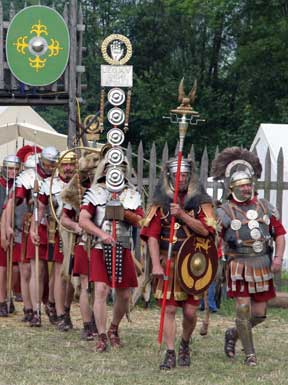
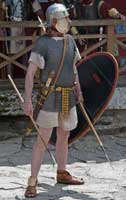

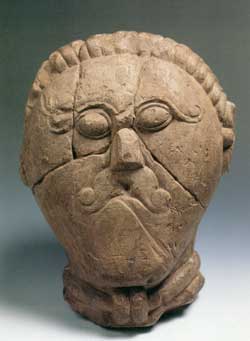

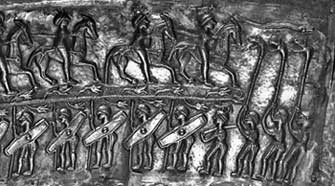
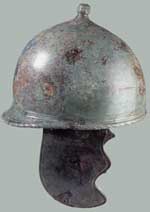 and were intended to terrify their opponents, much as bagpipes.
and were intended to terrify their opponents, much as bagpipes. 
